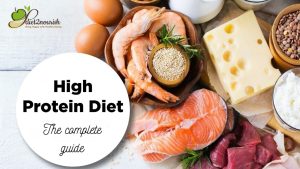A high protein diet chart can be a great way to promote weight loss, build muscle mass, and improve overall health. However, it’s important to choose protein sources that are nutrient-dense and balanced with other macronutrients. In this 500-word paragraph, we will discuss a high protein diet chart, providing examples of healthy protein sources and meal ideas.
When creating a high protein diet chart, it’s important to consider your individual needs and preferences. The recommended daily intake of protein is approximately 0.8 grams per kilogram of body weight, but some individuals may choose to consume more protein to promote weight loss or muscle gain. It’s also important to balance protein intake with other macronutrients, such as carbohydrates and fats, to ensure adequate intake of all essential nutrients.
Good sources of protein include lean meats, poultry, fish, eggs, dairy products, beans, and nuts. Here are some examples of high protein foods and meal ideas that can be incorporated into a high protein diet chart:
- Breakfast: Greek yogurt with mixed berries and chopped nuts, omelet with vegetables and cheese, protein smoothie with spinach, banana, and almond butter.
- Snacks: hard-boiled eggs, turkey or chicken breast slices, hummus with vegetables, cottage cheese with fruit.
- Lunch: grilled chicken or fish with roasted vegetables and quinoa, tuna or chicken salad with mixed greens, black bean and sweet potato bowl with avocado.
- Dinner: steak or salmon with roasted brussels sprouts and sweet potato, grilled chicken with asparagus and brown rice, tofu stir-fry with vegetables and cashews.
It’s also important to consider the timing of protein intake throughout the day. Consuming protein at each meal and snack can help promote satiety and prevent overeating. Additionally, consuming protein shortly after exercise can help promote muscle recovery and growth.
When following a high protein diet chart, it’s important to choose nutrient-dense protein sources and avoid sources that are high in saturated fat and processed additives. For example, instead of choosing processed meats like bacon or sausage, opt for lean sources of protein like turkey or chicken breast. Additionally, it’s important to include a variety of protein sources in your diet to ensure adequate intake of all essential amino acids.
Finally, it’s important to stay hydrated and consume plenty of fluids when following a high protein diet. Consuming high amounts of protein can put a strain on the kidneys, so it’s important to drink enough water and fluids to help flush out excess protein from the body. Additionally, consuming fiber-rich foods like fruits, vegetables, and whole grains can help prevent constipation, a potential side effect of a high protein diet.
In conclusion, a high protein diet chart can be a great way to promote weight loss, build muscle mass, and improve overall health. By incorporating nutrient-dense sources of protein into your diet and balancing protein intake with other macronutrients, you can create a healthy and satisfying meal plan that meets your individual needs and preferences. Consulting with a registered dietitian can also be helpful in creating a personalized high protein diet plan.
